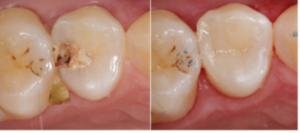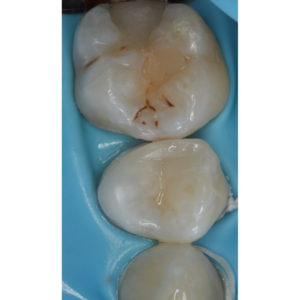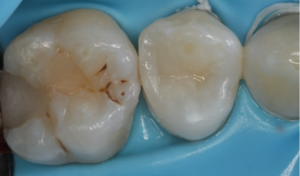What are Dental Fillings?
A filling is the process whereby decay is removed from a tooth, and a dental material is placed in the tooth. When decay is present, a filling is necessary to prevent the further spread of decay, and to restore the tooth to its natural shape.
Types of Fillings.
The main types of filling materials are composite, amalgam and glass ionomer. Many different types of dental materials are available which can be used to restore a tooth in a filling. The appropriate material will be selected by your dentist based on the specific tooth situation, and also taking into account your wishes and values.
Composite Fillings
Composite is the most commonly used filling material at Montagu Dental. It is a strong, white material, which has good wear resistance and bonds well to natural teeth. This means it can achieve a natural looking result which can last a long time if looked after. As composite material can be bonded directly to tooth tissue, no extra tooth removal is required, meaning a more conservative filling can be done.

Glass Ionomer Fillings
Glass ionomer is a white filling material. It is not as strong as composite or amalgam, but is faster to place and releases fluoride over time. This makes it an excellent choice for children’s filling in baby teeth. It is also sometimes used for semi-temporary fillings.
Amalgam Fillings
Amalgam fillings have a long-proven track record as been a successful dental material. However, many countries have now phased out amalgam fillings due to their mercury content. Although still legal in the United Kingdom, we no longer place amalgam fillings at Montagu Dental as we have such an excellent alternative (composite); which can be used instead and gives us strong fillings which not only look much better, but don’t contain mercury. Amalgam doesn’t adhere to tooth tissue, meaning an undercut is prepared in the tooth, and the material sets inside this undercut, so that it is locked into it like a jigsaw piece. This sometimes means that some healthy tooth tissue must be removed to allow it to stay in. This is another reason why we no longer choose to use amalgam.

You can book an appointment at our practice near Baker St, by clicking here.
Can an amalgam silver filling be replaced by a white composite filling?
Of course! This is something we love to do as the tooth always looks so much more natural. This will only be done however after careful assessment, as deeper fillings may be best left untouched if they are not causing any problems. The photos show a metal amalgam filling which I replaced with white composite to give a natural look while maintaining the health of the tooth.
How to care for your fillings for greater longevity.
Once you have had a filling, the tooth needs to be cared for in exactly the same way as a natural tooth does. This means regular tooth brushing, and interdental cleaning (cleaning between the teeth) with the use of floss, tepe brushes, or other dental cleaning tools. As always, we
Although fillings themselves cannot decay, the tooth around the filling can still get tooth decay, and gums can be irritated by bacteria. It is crucial to have regular dental check-ups to ensure that your fillings remain healthy, and regular hygiene appointments are advised.
Getting a cavity filled – what to expect.
Getting a cavity filled is no longer something to dread or be afraid of. Modern anaesthetic means that your filling should be completely pain-free. Your dentist will first apply some topical local anaesthetic gel to the area. This takes the ‘pinch’ out of the anaesthetic which is given a few minutes later.
Once you are comfortable, your dentist will then begin treatment. Often the dentist will place called a rubber dam over the teeth. This is a rubber sheet which allows the water from the drill to be suctioned directly away, rather than accumulating in your mouth. This is especially important if removing an amalgam filling, as it means that no mercury is ingested during removal. The biggest benefit of a rubber dam is that your filling will be placed in optimal dry conditions, which allows us to achieve the best bond possible between the tooth and the filling.
The decay is then removed using the dental drill. Although this can be a little noisy, it is not uncomfortable.
Once the cavity has been fully cleaned (all decayed tissue removed), the tooth is then filled by a careful protocol to restore the tooth to its natural shape.
When should I get a filling if I am also getting Invisalign or teeth whitening treatments?
Prior to any cosmetic treatments such as Invisalign or tooth whitening, it is essential to have any required fillings completed. This is because if decay is present, cosmetic treatments could potentially worsen the problems. Aside from this, our priority is the health of you and your teeth, and we would not complete any treatment before stabilising the health of your dentition first. This would always be assessed by your dentist at Montagu Dental prior to starting any cosmetic treatment.
How often do fillings need to be replaced?
Fillings can last an indefinite amount of time. There is no need to replace a filling just because it is a certain age. Fillings need replacing if they crack, break, or have signs of decay underneath them. Sometimes the tooth around a filling may show signs of cracks, and you may be advised to have a filling replaced, or in some cases something stronger such as an onlay or a crown.
Fillings at Montagu Dental
At Montagu Dental we pride ourselves by using the very latest techniques and materials to produce natural long-lasting fillings. I take photos of all my fillings, which allows me to show my patients at the end of their appointment exactly what I have been working on. Scroll down to see the steps involved in restoring a tooth with a typical composite filling.



Initial Situation/ Cavity
This tooth has a hole, and food is accumulating inside of it. X-rays have been taken which give us a good idea of the size of the cavity prior to starting.
Rubber Dam Application
The rubber dam is applied (read earlier to find out what this is!) The hole and decay can be better visualised at this stage.
Decay Removal
The tooth is cleaned, and decay is removed. Sometimes some affected tissue is left at the deepest part of the tooth, to avoid the dental nerve and keep the tooth alive. As long as it is completely surrounded by healthy tissue, this decay should be left as it can then no longer spread.
Tooth Restoration
Kept completely dry by the rubber dam, the tooth can then be carefully rebuilt using strong composite material.
Final Polish
The rubber dam is removed and the ‘bite’ is checked. We ask you to bite on some chalky paper, which leaves temporary marks on the teeth (seen in blue on the photo). This allows us to assess the filling and make sure it fits perfectly in your bite. The filling is then polished to give it a natural shine and the process is complete.

You can book an appointment, by clicking here.
To find out more about the steps during an Invisalign journey and to simulate your new smile, please click here.
Other articles you may like:
Prepare your teeth before your wedding day (whitening, hygiene, stain removal and dietary tips)
What does an Invisalign treatment journey look like? (Stages of treatment and smile simulator)





